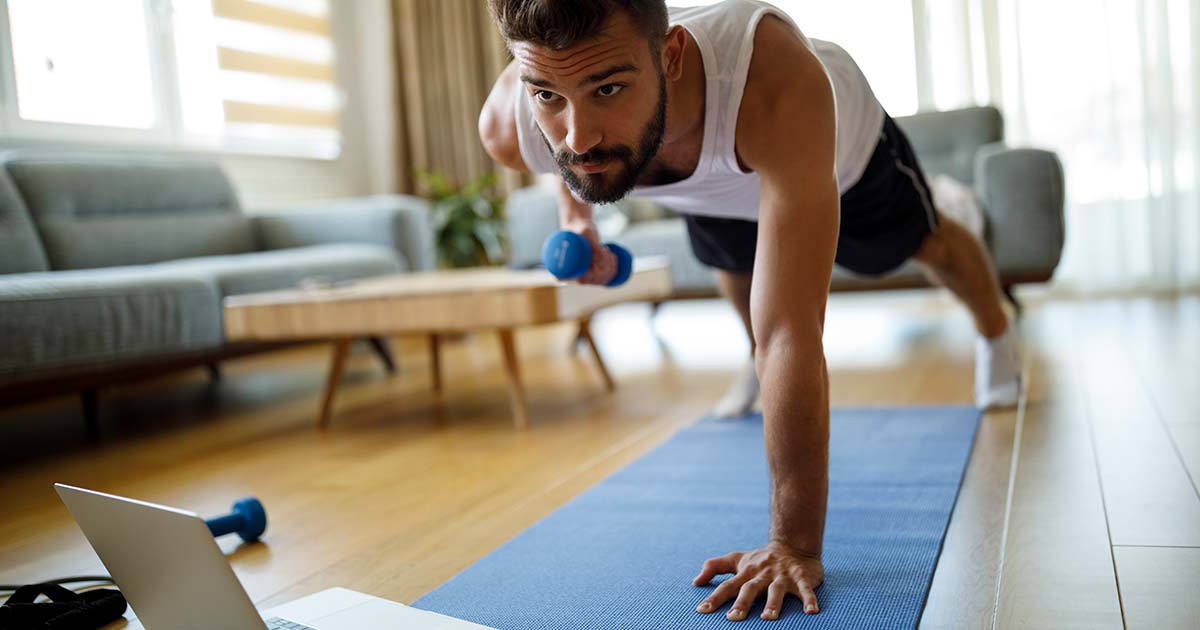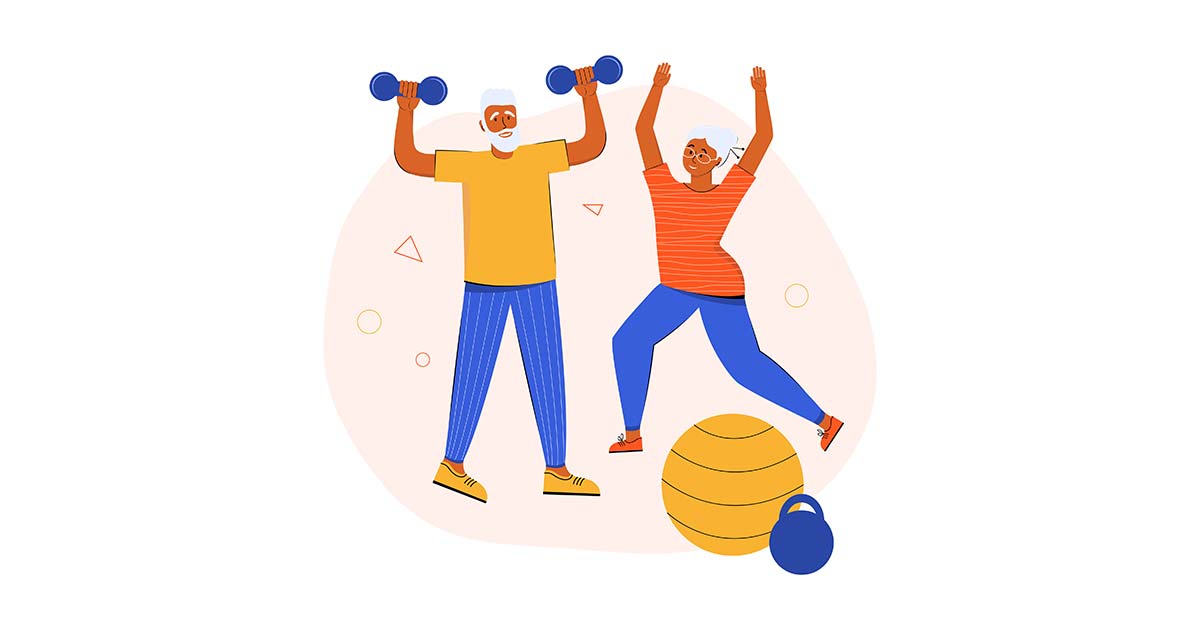
Advice to improve your movement, fitness, and overall health from the #1 in orthopedics in the U.S.
Lifestyle Medicine and the Benefits of Physical Activity
Learn more about how physical activity can improve your health, how much you should get, the best types to do, and more.
Advice to improve your movement, fitness, and overall health from the #1 in orthopedics in the U.S.

Yet many things can get in the way of exercise, such as chronic pain, challenging schedules, and lack of access to a gym. Heidi Prather, DO, who leads the HSS Lifestyle Medicine Program, shares information on the value of physical activity, how much you should be getting, how to start an exercise program, and ways to stay motivated.
How much physical activity should the average adult be getting?
The American College of Sports Medicine and the U.S. Centers for Disease Control and Prevention both agree that adults should aim for at least 150 minutes a week of moderate-intensity aerobic exercise or at least 75 minutes a week of vigorous-intensity aerobic exercise. Examples of moderate exercise are brisk walking and bicycle riding. Vigorous exercises include activities such as jogging and running. You can also combine moderate and vigorous exercise to achieve an equivalent mix of the two. In addition, you should do muscle-strengthening exercises (resistance training) on two or more days each week to strengthen all major muscle groups in the legs, hips, back, abdomen, chest, shoulders, and arms.
If this sounds like a lot, don't worry. You can break up the minutes into smaller, more manageable chunks of time, such as 30 minutes a day of moderate exercise five days a week. The 30 minutes do not need to be done consecutively; you can do two 15-minute workouts or three 10-minute workouts, for example. The goal is to keep moving because some physical activity is better than none at all. And the more you move, the more you will benefit.
How do I know if my activity intensity is moderate or vigorous?
There are equations you can use to determine your target heart rate, but the easiest way is to see how comfortable you are talking or singing while you exercise. If you can conduct a conversation or sing while you are moving, that is a moderate activity. If it is too difficult to talk or sing, you are engaging in vigorous exercise.
What kinds of physical activity should I do?
Your exercise program should include moderate to vigorous aerobic exercise to promote cardiovascular fitness and stamina; stretching to enhance flexibility; and weight training, resistance bands, or Pilates to strengthen muscles and promote joint stability. In addition, it is also helpful to incorporate balancing exercises, such as t’ai chi and yoga, which help you move more freely and safely and may reduce your risk of falling.
Also think about ways you can incorporate physical activity into your daily routine:
- Get off the subway or bus one or two stops early and walk the rest of the way to your destination.
- When shopping, park far out in the parking lot so you will have a longer walk to get to the store.
- Take stairs instead of the elevator whenever feasible.
- While watching television, get up and march in place for a few minutes during the commercials, or every 15 minutes if you are streaming entertainment.
How does physical activity integrate with the five other pillars of lifestyle medicine?
Sleep. Regular exercise can help you achieve high-quality, restorative sleep. In fact, going outside for a 10- to 15-minute walk each afternoon helps you fall asleep better because it encourages the release of melatonin at bedtime.
Nutrition. Physical activity is an excellent component of a heart-healthy, cancer-reducing lifestyle that also includes a nutritious diet high in plant-based foods and low in fat. Together, a healthy diet and weight-bearing exercise can increase bone density.
Stress management. Exercise helps improve mood and can be beneficial for reducing stress. When you're feeling overwhelmed, take a short walk if you can or go to the gym, and see how you feel afterward.
Social connectedness. Physical activity helps promote social connectedness if you exercise with other people, which gives you a chance to connect emotionally with others while gaining benefits for your body.
Avoidance of risky substances. Many of the clients we see in our program have musculoskeletal complaints that sometimes keep them from exercising, such as chronic pain from osteoarthritis. Studies show, however, that exercise can be as effective as an opioid medication for controlling chronic musculoskeletal pain.
I haven't exercised in a very long time. How do I get started?
The first thing to do, especially if you have heart disease, uncontrolled high blood pressure, or another chronic medical condition, is to see your doctor for medical clearance to exercise. You want to be sure the activities you choose are safe for you. Your physician can give you some ideas of exercises to start with, such as brisk walking or riding a stationary bike. A physical therapist, exercise kinesiologist, or trainer can also be helpful to teach you how to use gym equipment and create a muscle strengthening routine for you.
Once you've begun, set manageable goals. Walk for 10 minutes at a time, for example, and increase the time spent on the activity by 10% (for example, 1 minute of a 10-minute walk) every three days.
I get excited when I start exercising and then after a while, it's hard to stay motivated. How do I maintain my physical activity program?
When you lose your motivation, ask yourself, "Why did I start this in the first place?" Did you want to feel better, sleep better, lose weight, or play with your kids or grandchildren? Remind yourself why you wanted to become more physically active and then think about how you’ve been feeling since you started. Do your joints hurt less? Has your mood been better? Are you sleeping more soundly? Checking in with how you're feeling now compared to before you were exercising can help you reflect on how far you've come and the benefits you are already experiencing. That can be very motivating.
It is also helpful to do a variety of activities, choosing those you enjoy the most. Perhaps you walk on certain days of the week and ride a bike or swim on the other days. A varied schedule is more interesting than doing the same exercise day after day.
You might consider setting a goal for yourself such as a walking tour in another country, a fishing trip with your grandkids, or even walking a 5K. Having something to shoot for is a great motivator.
If you are interested in improving your exercise game, find out how lifestyle medicine may help you. Lifestyle Medicine services at HSS are provided in person and through telehealth. Call 212-774-7653 for more information.
HSS offers exercise classes that are accessible to all and are taught by certified instructors who specialize in muscle, joint, and bone conditions — with a commitment to your safety. Livestreamed and OnDemand exercise classes include T’ai Chi, Pilates Mat, and Yoga. Learn more.
Published 1/12/2023


